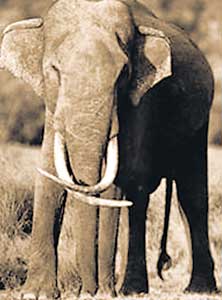
News from the WildernessThe heavy rains that inundated the North Central Province has now given way to brighter days in elephant country. A contributing factor could be the general belief that rains settle after the Vesak full moon. At this time we observe a trickling of herds of elephants moving towards the Minneriya National Park. It's almost as if these giant beasts are in transit, because they are neither seen in large numbers at the Eco Park nor are they found in significant numbers at Minneriya.
Hopefully, they will keep out of harm's way until about mid – June when they find their way to the protected boundaries of Minneriya, which will be home for these pachyderms for the next couple of months. Three tuskers observed at the Eco Park are expected to visit Minneriya this season. This will, no doubt, make the viewing even more interesting. My mind goes back five years when we witnessed as many as 12 tuskers every evening at Minneriya during the "Gathering." It was indeed an awesome sight. Let's hope that this year proves to be as entertaining. Nature Odyssey staff and the Chaaya Village team will keep a close eye on the herds and keep our junior visitors informed about the arrival of these gentle giants. Till then, keep working on your photographic skills. Remember that there is no photographer who's made good pictures without many practice sessions. Kids did you know? Elephant Tusks
|
|
||||||
|| Front
Page | News | Editorial | Columns | Sports | Plus | Financial
Times | International | Mirror | TV
Times | Funday
Times || |
| |
Reproduction of articles permitted when used without any alterations to contents and a link to the source page.
|
© Copyright
2008 | Wijeya
Newspapers Ltd.Colombo. Sri Lanka. All Rights Reserved. |
